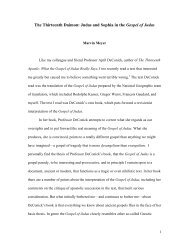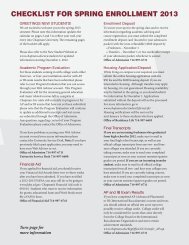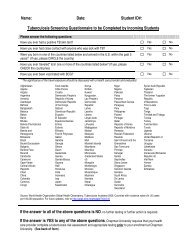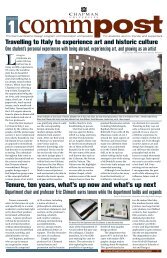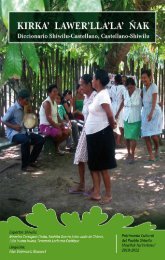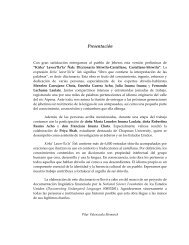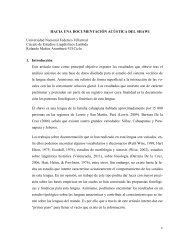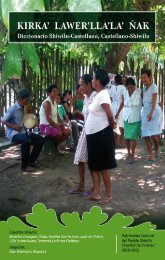“Surplus Humanity” and the Margins of Legality - Chapman University
“Surplus Humanity” and the Margins of Legality - Chapman University
“Surplus Humanity” and the Margins of Legality - Chapman University
Create successful ePaper yourself
Turn your PDF publications into a flip-book with our unique Google optimized e-Paper software.
Do Not Delete 12/12/2010 7:34 PM<br />
4 <strong>Chapman</strong> Law Review [Vol. 14:1<br />
saturated by legality, contemplate a slum like Dharavi. 16 Ra<strong>the</strong>r,<br />
slums emerge as liminal spaces 17 where law, extra-legality, <strong>and</strong><br />
illegality are braided to produce <strong>the</strong> o<strong>the</strong>r side <strong>of</strong> universality—<br />
―moral <strong>and</strong> legal no man‘s l<strong>and</strong>, where universality finds its<br />
spatial limits.‖ 18<br />
This article examines <strong>the</strong> production <strong>and</strong> persistence <strong>of</strong><br />
urban slums in order to explore <strong>and</strong> evaluate remedial strategies<br />
that could ensure adequate housing for <strong>the</strong> urban poor. This<br />
inquiry is informed by <strong>the</strong> spatial turn in social inquiry that<br />
deems spatial factors crucial to social phenomena, 19 <strong>and</strong> <strong>the</strong><br />
renewed interest in urban sociology <strong>and</strong> ―<strong>the</strong> city.‖ 20 It takes<br />
cognizance <strong>of</strong> <strong>the</strong> mutually constitutive roles <strong>of</strong> law <strong>and</strong> space, 21<br />
<strong>and</strong> <strong>of</strong> <strong>the</strong> fact that ―[w]e live in a time <strong>of</strong> porous legality or <strong>of</strong><br />
legal porosity, multiple networks <strong>of</strong> legal orders forcing us to<br />
constant transitions <strong>and</strong> trespassings.‖ 22 First, <strong>the</strong> article<br />
presents a picture <strong>of</strong> Dharavi to underscore <strong>the</strong> complexity <strong>and</strong><br />
gravity <strong>of</strong> <strong>the</strong> problem <strong>of</strong> urban slums. Second, it articulates a<br />
<strong>the</strong>oretical framework to argue that urban slums are produced by<br />
16 See JURGEN HABERMAS, THE STRUCTURAL TRANSFORMATION OF THE PUBLIC<br />
SPHERE: AN INQUIRY INTO A CATEGORY OF BOURGEOIS SOCIETY 74–75 (1999). See<br />
generally HABERMAS AND THE PUBLIC SPHERE (Craig Calhoun ed., 1993); AFTER<br />
HABERMAS: NEW PERSPECTIVES ON THE PUBLIC SPHERE (Nick Crossley & John Michael<br />
Roberts eds., 2004).<br />
17 According to Victor Turner:<br />
The attributes <strong>of</strong> liminality or liminal personae (‗threshold people‘) are<br />
necessarily ambiguous, since this condition <strong>and</strong> <strong>the</strong>se persons elude or slip<br />
through <strong>the</strong> network <strong>of</strong> classifications that normally locate states <strong>and</strong> positions<br />
in cultural space. Liminal entities are nei<strong>the</strong>r here nor <strong>the</strong>re; <strong>the</strong>y are betwixt<br />
<strong>and</strong> between <strong>the</strong> positions assigned <strong>and</strong> arrayed by law, custom, convention,<br />
<strong>and</strong> ceremonial.<br />
VICTOR TURNER, THE RITUAL PROCESS: STRUCTURE AND ANTI-STRUCTURE 95 (1969).<br />
18 Denise Ferreira Da Silva, Towards a Critique <strong>of</strong> <strong>the</strong> Socio-logos <strong>of</strong> Justice: The<br />
Analytics <strong>of</strong> Raciality <strong>and</strong> <strong>the</strong> Production <strong>of</strong> Universality, 7 SOC. IDENTITIES 421, 422<br />
(2001).<br />
19 See generally DAVID HARVEY, THE CONDITION OF POSTMODERNITY: AN ENQUIRY<br />
INTO THE ORIGINS OF CULTURAL CHANGE (1990); EDWARD W. SOJA, POSTMODERN<br />
GEOGRAPHIES: THE REASSERTION OF SPACE IN CRITICAL SOCIAL THEORY (1989); SPACE &<br />
SOCIAL THEORY: INTERPRETING MODERNITY AND POSTMODERNITY (Georges Benko & Ulf<br />
Strohmayer eds., 1997); PLACE AND THE POLITICS OF IDENTITY (Michael Keith & Steve<br />
Pile eds., 1993).<br />
20 See, e.g., EDWARD W. SOJA, POSTMETROPOLIS: CRITICAL STUDIES OF CITIES AND<br />
REGIONS xi, xii (2000); ASH AMIN & NIGEL THRIFT, CITIES: REIMAGINING THE URBAN 2–4<br />
(2002); POSTMODERN CITIES AND SPACES 1 (Sophie Watson & Ka<strong>the</strong>rine Gibson eds.,<br />
1995).<br />
21 See generally Nicholas K. Blomley, Text <strong>and</strong> Context: Rethinking <strong>the</strong> Law-Space<br />
Nexus, 13 PROGRESS IN HUM. GEOGRAPHY 512 (1989); NICHOLAS K. BLOMLEY, LAW,<br />
SPACE, AND THE GEOGRAPHIES OF POWER (1994); Desmond M<strong>and</strong>erson, Beyond <strong>the</strong><br />
Provincial: Space, Aes<strong>the</strong>tics, <strong>and</strong> Modernist Legal Theory, 20 MELB. U. L. REV. 1048<br />
(1996); Chris Butler, Critical Legal Studies <strong>and</strong> <strong>the</strong> Politics <strong>of</strong> Space, 18 SOC. & LEGAL<br />
STUD. 313 (2009).<br />
22 BOAVENTURA DE SOUSA SANTOS, TOWARD A NEW COMMON SENSE: LAW, SCIENCE<br />
AND POLITICS IN THE PARADIGMATIC TRANSITION 473 (1995).




